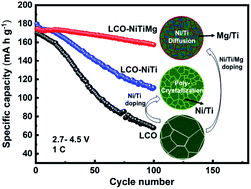Interplay between multiple doping elements in high-voltage LiCoO2†
Abstract
Pursing a higher upper cutoff voltage rejuvenates conventional LiCoO2 (LCO) in the application of high-energy-density Li-ion batteries. Recently, multiple element doping (Q. Liu et al., Nature Energy, 2018, 3, 936–943; J. N. Zhang et al., Nature Energy, 2019, 4, 594–603) has pushed the upper cutoff voltage to 4.5 and even 4.6 V for achieving a higher energy density. However, reports about the spatial distribution of doping elements in high-voltage LCO are in chaos, and even in conflict. Herein, the interplay between doping elements is clearly revealed by systemic structural and chemical analysis in Ni–Ti–Mg co-doping LCO. When Ni and Ti were employed, they introduced a great extent of poly-crystallization in the original single-crystal LCO, and more importantly, Ti was found to cooperate with Ni to enrich the grain boundary, constructing a stable shell to protect the layered lattice in the bulk. Further introducing Mg induces Ni/Ti to diffuse into the bulk to form the lattice doping, and moreover Mg was segregated at the grain boundary with tiny Ti, delivering a high capacity retention of 90% even after 100 cycles at 4.5 V. These findings answer the previous debate about the distribution of doping elements, and provide more guidance for the design of new doping strategies for high-energy-density LCO cathodes and beyond.



 Please wait while we load your content...
Please wait while we load your content...